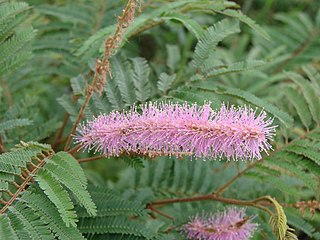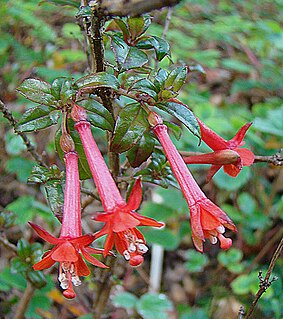
Mimosa is a genus of about 400 species of herbs and shrubs, in the mimosoid clade of the legume family Fabaceae. The generic name is derived from the Greek word μῖμος (mimos), an "actor" or "mime", and the feminine suffix -osa, "resembling", suggesting its 'sensitive leaves' which seem to 'mimic conscious life'.
Mimosa andina is a species of plant in the family Fabaceae. It is found only in Ecuador. Its natural habitat is subtropical or tropical dry shrubland.
Mimosa disperma is a species of plant in the family Fabaceae. It is found only in Ecuador. Its natural habitat is subtropical or tropical dry forests.
Mimosa townsendii is a species of plant in the family Fabaceae. It is found only in Ecuador. Its natural habitat is subtropical or tropical dry shrubland.

Mimosa verrucosa, commonly known as jurema-branca or jurema-de-oeiras, is a species of legume of the genus Mimosa, in the common bean family, Fabaceae.
Byttneria loxensis is a species of flowering plant in the family Malvaceae. It is found only in Ecuador. Its natural habitat is subtropical or tropical dry shrubland.
Guevaria loxensis is a species of flowering plant in the family Asteraceae. It is found only in Ecuador. Its natural habitat is subtropical or tropical moist montane forests. It is threatened by habitat loss.
Chusquea loxensis is a species of grass in the family Poaceae. The bamboo is endemic to Ecuador.
Salvia loxensis is a species of flowering plant in the family Lamiaceae that is native to Ecuador. Its natural habitats are subtropical or tropical moist montane forests and subtropical or tropical high-altitude shrubland.

Archidendron bigeminum is a tree species in the legume family (Fabaceae). It is found in India and Sri Lanka. It is known as "Kalitiya - කලටිය" in Sinhala people.
Aphelandra loxensis is a species of plant in the family Acanthaceae. It is endemic to Ecuador. Its natural habitat is subtropical or tropical moist montane forests. It is threatened by habitat loss.

Fuchsia loxensis is a species of fuchsia in the family Onagraceae. It is endemic to Ecuador.
Phlegmariurus loxensis is a species of plant in the family Lycopodiaceae. It is endemic to Ecuador, where it occurs in the páramo and forests of the Andes. It is threatened by fire in its habitat.
Meriania loxensis is a species of plant in the family Melastomataceae. It is endemic to Ecuador. Its natural habitats are subtropical or tropical moist montane forests and subtropical or tropical high-altitude shrubland.
Monnina loxensis is a species of plant in the family Polygalaceae. It is endemic to Ecuador.
Nasa loxensis is a species of plant in the Loasaceae family. It is endemic to Ecuador. Its natural habitat is subtropical or tropical moist montane forests.
Passiflora loxensis is a species of plant in the family Passifloraceae. It is endemic to Ecuador.
Roupala loxensis is a species of plant in the family Proteaceae. It is endemic to Ecuador.
Siphocampylus loxensis is a species of plant in the family Campanulaceae. It is endemic to Ecuador. Its natural habitat is subtropical or tropical moist montane forests. It is threatened by habitat loss.
Weinmannia loxensis is a species of plant in the family Cunoniaceae. It is endemic to Ecuador. Its natural habitat is subtropical or tropical moist montane forests.




